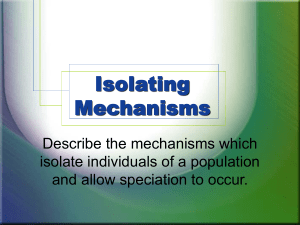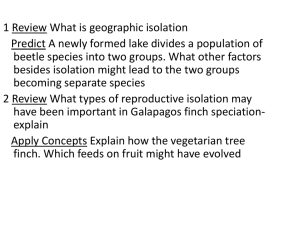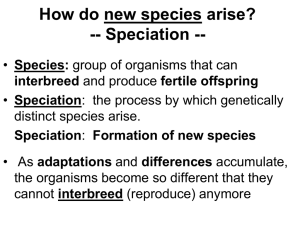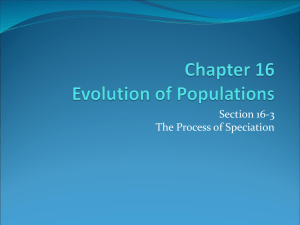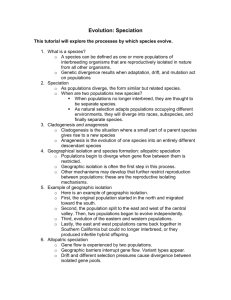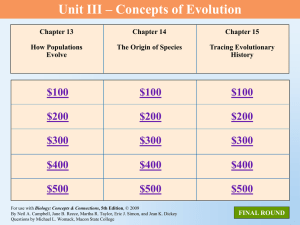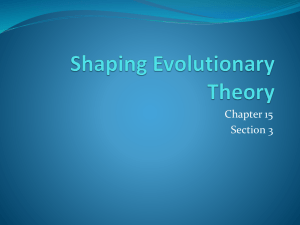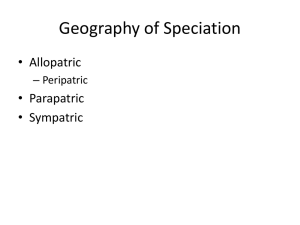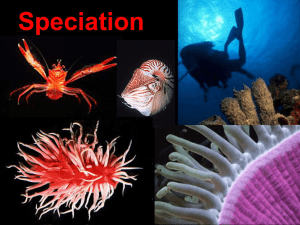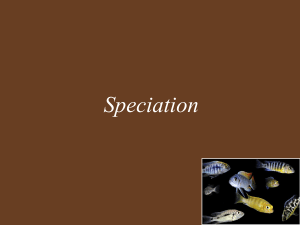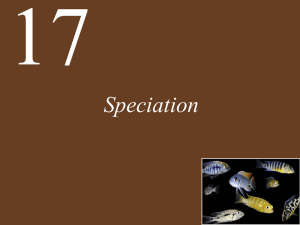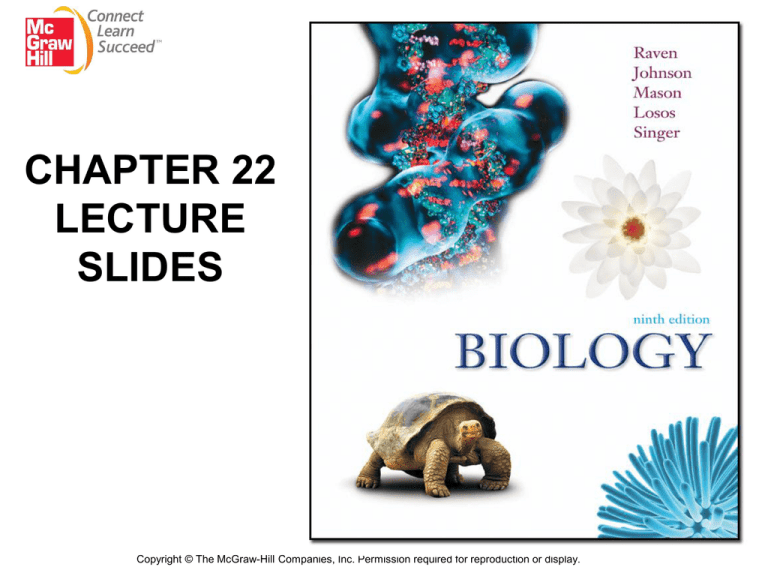
CHAPTER 22
LECTURE
SLIDES
Copyright © The McGraw-Hill Companies, Inc. Permission required for reproduction or display.
The Origin of Species
Chapter 22
2
The Nature of Species
• The concept of species must account for
two phenomena:
– The distinctiveness of species that
occur together at a single locality
– The connection that exists among
different populations belonging to the
same species
3
• Sympatric species occur together in an area
– Are distinctive entities
– Are phenotypically different
– Utilize different parts of the habitat
– Behave separately
• Even if they look alike to us, the organisms
themselves have no such difficulties
4
• Subspecies
– Within a single species, individuals in
populations that occur in different areas
may be distinct from one another
• Even though geographically distant
populations may appear distinct, they
are usually connected by intervening
populations that are intermediate in their
characteristics
5
6
The Biological Species Concept
• Ernst Mayr defined species as…
“…groups of actually or potentially
interbreeding natural populations which are
reproductively isolated from other such
groups”
• Species composed of populations whose
members mate with each other and produce
fertile offspring
• Reproductive isolation – do not mate with
each other or do not produce fertile offspring
7
• Reproductive isolating mechanisms
– Prezygotic isolating mechanisms
•
•
•
•
•
•
Geographic isolation
Ecological isolation
Behavioral isolation
Temporal isolation
Mechanical isolation
Prevention of gamete fusion
– Postzygotic isolating mechanisms
• Hybrid inviability or infertility
8
• Ecological isolation
– Tiglons do not occur in the wild
– Lions and tiger ranges overlap in India but
they use different habitats
9
• Behavioral isolation
– Blue-fotted boobies select mates after an
elaborate courtship display
– Will not mate with other boobies
10
• Sympatric species avoid mating with
members of the wrong species in a
variety of ways, including differences in:
– Visual signals
– Sound production
– Chemical signals: pheromones
– Electrical signals: electroreception
11
Copyright © The McGraw-Hill Companies, Inc. Permission required for reproduction or display.
Amplitude (dB)
Chrysoperla
plorabunda
Chrysoperla
adamsi
Chrysoperla
johnsoni
0
1
2
3
4 5 6 7 8
Time (seconds)
9 10 11 12
• Lacewings rely on auditory signals to
attract mates
• Females are able to distinguish calls of
different species
12
• Temporal isolation
– 2 species of wild lettuce grow along
roadsides in the SE U.S.
– Hybrids can be made experimentally and
are fertile
– Rare in nature because one flowers in
early spring and the other in summer
13
• Mechanical isolation
– Structure of the male and female
copulatory organs may be incompatible
– Bees may carry the pollen of one species
on a certain place on their bodies; if this
area does not come into contact with the
receptive structures of the flowers of
another plant species, the pollen is not
transferred
14
• Prevention of gamete fusion
– In animals that shed gametes directly into
water, the eggs and sperm derived from
different species may not attract or fuse
with one another
– In plants, the growth of pollen tubes may
be impeded in hybrids between different
species
15
• Postzygotic isolating mechanisms
– Leopard frogs form a group of related
species
• Many hybrids cannot be produced even in the
laboratory
– Hybrids that do survive may be weaker
– Hybrids may be sterile – mules
• Abnormal sex organs
• Failure to form gametes
16
17
• Criticisms of biological species concept:
– Reproductive isolation may not be the only
force maintaining species integrity
– Interspecific hybridization
• 50% of California plant species, in one study,
not well defined by genetic isolation
• 10% of world’s 9500 bird species known to
hybridize in nature
18
• Ecological species concept
– Distinctions among species are maintained
by natural selection
– Stabilizing selection maintains the species’
adaptations
– Hybrids are quickly eliminated from gene
pool
19
• Other weaknesses of biological species
concept
– Difficult to apply the concept to populations
that are geographically separated in nature
– Many species that do not hybridize in the
wild will do so in captivity
– Many organisms are asexual
20
Reproductive Isolation
• Cladogenesis
– One ancestral species becomes divided
into two descendant species
• If species are defined by the existence
of reproductive isolation,
– Then the process of speciation is identical
to the evolution of reproductive isolating
mechanisms
21
• Selection may reinforce isolating mechanisms
– Formation of species a continuous process
– 2 populations may be only partially reproductively
isolated
– Reinforcement – initially incomplete isolating
mechanisms are reinforced by natural selection
until they are completely effective
– Reinforcement is not inevitable – hybrids may be
inferior but may still be fertile – serve as conduit of
genetic exchange
22
• Pied flycatcher and collared flycatcher appear very
similar where they occur alone
• In areas where they are sympatric, differences in
color and pattern allow individuals to avoid
hybridizing
23
Genetic Drift
• Random changes may cause
reproductive isolation
– Genetic drift in small populations
– Founder effects
– Population bottlenecks
• Hawaiian Islands: Drosophila differ in
courtship behavior
– Changes in courtship behavior between
ancestor and descendant population may
be the result of founder events
24
• Adaptation can lead to speciation
– As populations of a species adapt to
different circumstances, they likely
accumulate many differences that may
lead to reproductive isolation
– Changes in dewlap color related to
environment
• If you can’t be seen, you don’t mate
• Could lead to reproductive isolation from
ancestral population
25
26
Geography of Speciation
• Speciation is a 2-part process
– Initially identical populations must diverge
– Reproductive isolation must evolve to
maintain these differences
• Homogenizing effect of gene flow
erases differences
• Speciation more likely in geographically
isolated populations
27
Copyright © The McGraw-Hill Companies, Inc. Permission required for reproduction or display.
a.
b.
c.
28
Allopatric speciation
• Geographically separated, or allopatric,
populations appear much more likely to
have evolved substantial differences
leading to speciation
• Little paradise kingfisher varies little
throughout range
– Isolated populations are strikingly different
from each other and mainland population
29
Copyright © The McGraw-Hill Companies, Inc. Permission required for reproduction or display.
Isolated island
population
of kingfishers
Isolated island
population
of kingfishers
Mainland
population
of kingfishers
NEW
GUINEA
PACIFIC
OCEAN
Isolated island
population
of kingfishers
Mainland
population
of kingfishers
30
Sympatric speciation
• One species splits into two at a single
locality, without the two new species
ever having been geographically
separated
• One type occurs commonly as the result
of polyploidy
– Individuals that have more than two sets of
chromosomes
31
• 2 ways polyploidy occurs
– Autoploidy
• All the chromosomes arise from a single
species
• Error in cell division produces tetraploids
• Cannot produce fertile offspring with normal
diploids
32
• Allopolyploidy
– Two species hybridize
– Resulting offspring have one copy of the
chromosomes of each species
– Infertile: cannot reproduce with either
species – can’t produce gametes
– Can reproduce asexually
– Can become fertile if chromosomes
spontaneously doubled (polyploidy)
33
34
• Sympatric speciation may occur over
the course of multiple generations
through disruptive selection
– Cause a population to contain individuals
exhibiting two different phenotypes
• Two phenotypes would have to evolve
reproductive isolating mechanisms
• Two phenotypes could be retained as
polymorphism within a single population
35
Adaptive radiations
• Closely related species that have
recently evolved from a common
ancestor by adapting to different parts
of the environment
• Occurs
– In an environment with few other species
and many resources
• Hawaiian and Galápagos Islands
– Catastrophic event leading to extinction of
other species
36
• Key innovation
– New trait evolves
within a species
allowing it to use
resources that were
previously
inaccessible
• Lungs in fish
• Wings in birds
– Requires both
speciation and
adaptation to
different habitats
• Island archipelago
example
37
38
• Character displacement
– Natural selection in each species favors
those individuals that use resources not
used by the other species
• Greater fitness
• Trait differences in resource use will increase in
frequency over time
• Species will diverge
39
Individuals in each species that are most different
from the other species (circled) will be favored by
natural selection, because they will not have to
compete with the other species
40
Hawaiian Drosophila
• > 1000 species of Drosophila on
Hawaiian Islands
• Diversity of morphological and
behavioral traits
• Empty habitats resulted in fruit flies that
are:
-Predators
-Herbivores
-Nectar eaters
-Parasites
-Detritivores
41
Darwin’s finches
• Ancestors reached these islands before other
land birds
• Subjected to different selective pressures as
they adopted new lifestyles
• Geographic isolation on many islands
• Diverse population, some evolved into
separate species
• Occupy many different habitats
42
• Differences between species likely resulted
from character displacement as initially
similar species diverged to minimize
competitive pressures
• Ground finches
– Feed on seeds: size of bill relates to size of seed
they eat
• Tree finches
– All eat insects: one species uses a tool to get
insects
• Vegetarian finch
– Eats buds from branches
• Warbler finches
– Eat insects from leaves and branches
43
44
Lake Victoria cichlid fishes
• Immense, shallow, freshwater sea in equatorial East
Africa
• Was home to over 300 species of cichlid until
recently
• Sequencing of cytochrome b gene reveals first
cichlids arrived 200,000 years ago
• Changes in water level encouraged species
formation
• Lake dry down 14,000 years ago may have
stimulated speciation by isolating populations
45
• Cichlids are small, perchlike fishes
• Males very colorful
• Sense of diversity in how they eat
– Mud biters, algae scrapers, leaf chewers, snail
crushers, zooplankton eaters, insect eaters, prawn
eaters, fish eaters
• Key innovation – carry a second set of
functioning jaws
• Abrupt extinction in the last several decades
– 1950s: Nile perch introduced into lake
– 1990s: 70% of cichlids extinct
46
47
New Zealand alpine buttercups
• Speciation and diversification have
been promoted by repeated cycles of
glacial advance and retreat
• 14 species occupy 5 distinct habitats
• Snowfields: 2130–2740 m elevation
• Snowline fringe: 1220–2130 m elevation
• Stony debris: slopes at 610 to 1830 m
• Sheltered: 305–1830 m
• Boggy habitats: 760–1525 m elevation 48
49
The Pace of Evolution
• Gradualism
– Accumulation of small changes
– Standard view for a long time
• Punctuated equilibrium
– Long periods of stasis followed by rapid change
– Stabilizing and oscillating selection is
responsible for stasis
• Gradualism and punctuated equilibrium are
two ends of a continuum
50
51
Speciation and Extinction
• Speciation, through time, has surpassed
extinction
• Five mass extinctions have occurred
– Most severe at the end of the Permian
period – 96% of all species may have
perished
– End of the Cretaceous: dinosaurs went
extinct
• Asteroid caused global forest fires and shroud
of particles
52
• Not all groups affected equally by mass
extinctions
• Previously dominant groups may perish,
changing the course of evolution
– Dinosaurs went extinct; mammals began
their radiation
• Species diversity does rebound after
mass extinction
– Speciation rates may take 10 million years
to reach former maximum
53
• 6th extinction
underway
– 25% of all
species may
become
extinct in the
near future
– Rebound will
be slower
due to
humans
taking up
resources
54


